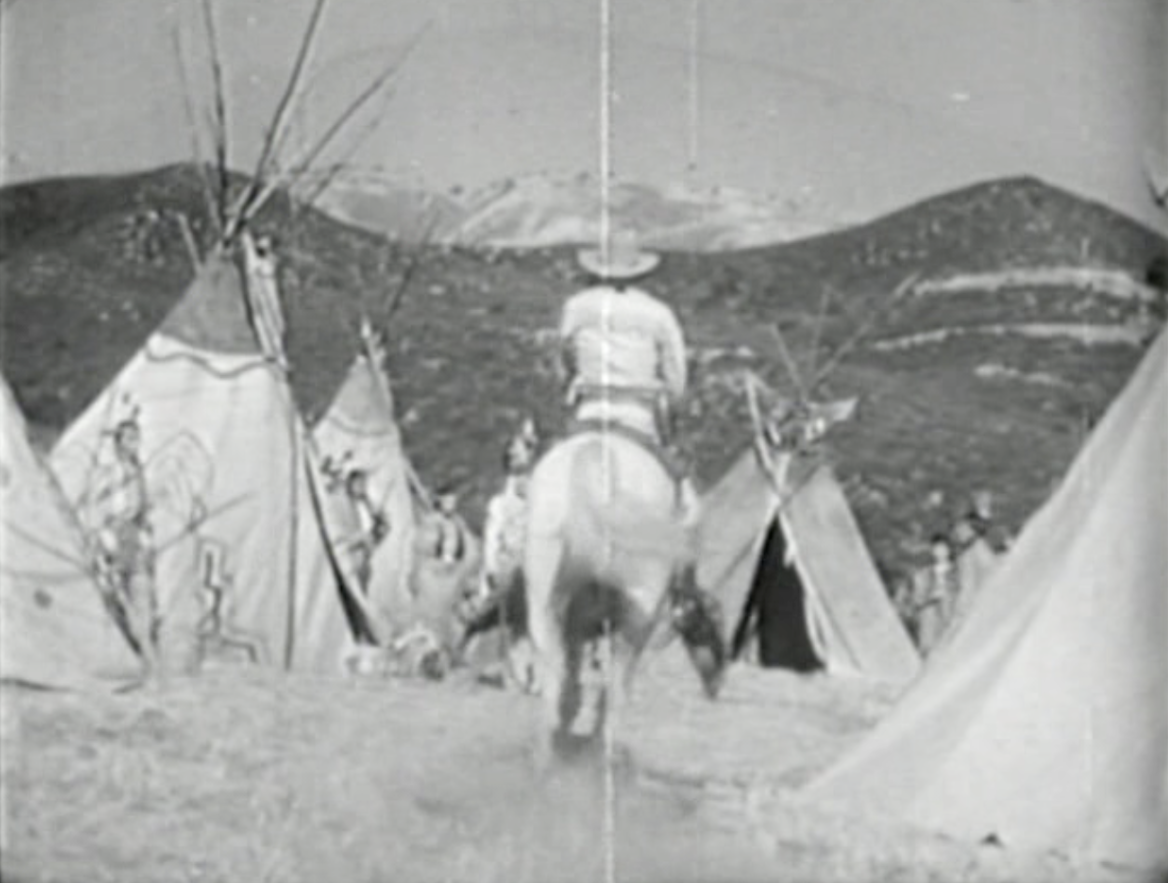born July 1898, Arizona
died November 1946, Hollywood (age 48)
While it’s possible that the artistic “brilliance” of Cline’s fuzzy visual poetry in this strange and wonderful movie is purely accidental, it seems unlikely. Shot after shot reveals subtle, elusive images, often tucked away in the corners of the frame. For the viewer who is able to relax into it and surrender to the weirdness of it all, it adds up to a cinematic experience that is more akin to spotting faces in the clouds or looking at a book of hidden-eye puzzles than it is to watching a typical B-Western.
"Fugitive Valley" (1941) — a leap off Range Rider Rock
Regardless of whether Cline intentionally injected illusions into his work, whether it’s all attributable to a bad print or whether the often puzzling images in his shots are purely imaginary, he showed a flair for Iverson in a solid string of 1940s B-Westerns, part of an ephemeral career that began in the silent era and soon saw Cline emerge as one of the key shooters in early sound Westerns.
"Range Beyond the Blue" (1947) — holdup gang
waiting for the stage in front of a rock I call Tamale
By the time the genre hit its stride in the mid-1930s he was already a master of the outdoor action sequence, had already developed much of his unique visual style and had already begun shooting at the Iverson Movie Ranch. Working mostly with smaller outfits — including Trem Carr Pictures and William Berke Productions in the early days and later the Alexander brothers and A.W. Hackel’s Supreme Pictures — Cline found himself at the center of what was suddenly the hottest film commodity in the business, the B-Western.
"Western Cyclone" (1943) — riderless horse on the Upper Iverson,
with Pyramid Peak and the Rocky Peak area in the background
"Buffalo Bill Rides Again" (1947) — teepee village on the Upper Iverson,
with Oat Mountain in the background, center, flanked by
Two-Humper, left, and Notch Hill, right
Much of his best Iverson work was done during this Range Busters/PRC period, including the Range Busters installments Underground Rustlers
An early Iverson standout for Cline is the 1938 Bob Steele feature Paroled to Die
"Buffalo Bill Rides Again" — Hangover Shack in the background
He rarely stayed long in any one place, adding to the mystique of Robert Cline as a restless and perhaps troubled genius. He avoided the one thing that almost all major Iverson cinematographers share: a lengthy stay at Republic Pictures. Maybe it’s part of his genius that he found a way to keep himself from getting sucked into the machine in a big way, something almost no one else seemed able to resist.
Thunder River Feud — Hangdog, a sandstone giant
on the Iverson Movie Ranch
on the Iverson Movie Ranch
One of Robert Cline’s later career highlights is the Lash LaRue movie Law of the Lash from PRC, released in 1947, after Cline’s death.
from PRC, released in 1947, after Cline’s death.
Like many of the cinematographers of the B-Western era, Robert Cline was born out West. He came from Arizona, which may have helped instill his affinity for Westerns and the Western landscape. And like so many of the cinematographers of the period, he died young — in his case even younger than most, at 48. But he also started young, well back into the silent era. His career essentially spanned 1925-1946, with a few releases coming out after his death, in 1947, and he left behind a legacy of 139 productions listed in his filmography — all well worth a look, if I can say so after having only seen a fraction of them. Cline lived long enough to see television coming, but he died before he got his chance to work in the new medium.
"Thunder in the Desert" (1938) — Hangdog in the background
Like many of the cinematographers of the B-Western era, Robert Cline was born out West. He came from Arizona, which may have helped instill his affinity for Westerns and the Western landscape. And like so many of the cinematographers of the period, he died young — in his case even younger than most, at 48. But he also started young, well back into the silent era. His career essentially spanned 1925-1946, with a few releases coming out after his death, in 1947, and he left behind a legacy of 139 productions listed in his filmography — all well worth a look, if I can say so after having only seen a fraction of them. Cline lived long enough to see television coming, but he died before he got his chance to work in the new medium.











No comments:
Post a Comment